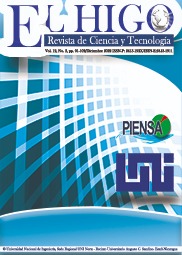Fitorremediación de suelos contaminados por metales pesados: una revisión
DOI:
https://doi.org/10.5377/elhigo.v12i2.15197Palabras clave:
Fitorremediación de suelos contaminados, Metales Pesados, biodisponibilidad, desafíos, disposición de la biomasaResumen
El presente artículo tiene como objetivo proporcionar una descripción de los conceptos básicos de la fitorremediación como una tecnología amigable y viable para la remediación de los suelos por metales pesados. Mediante la recopilación de documentación en base de datos confiables y una revisión de literatura disponible, se incluyeron publicaciones vinculados a la fitorremediación de sitios contaminados. Dentro de la fitorremediación existen diferentes estrategias como la fitoextracción, fitoestabilización y fitovolatilización, que poseen ventajas como la remoción permanentemente de los metales del suelo sin alterar la calidad del suelo, contribuye a restaurar la vegetación del sitio y reducir la erosión del suelo, además, se puede aplicar de manera in situ o e x situ. Sin embargo, entre sus desventajas se encuentra el periodo de tiempo prolongado, la fitotoxicidad de las plantas y biodisponibilidad del metal, y el tratamiento de la biomasa contaminada cuyas alternativas de manejo incluyen su deposición en vertederos para desechos peligrosos o incineración para la purificación y recuperación de los metales pesados. Otra alternativa es la utilización de la biomasa como bioenergía, no obstante, existe poco conocimiento sobre las emisiones que se podrían generar durante este proceso. Entre los desafíos de la fitorremediación se encuentran la baja tasa de crecimiento de las plantas, raíces poco profundas y poca producción de biomasa, así como las plagas y enfermedades que pueden reducir la eficiencia en la remoción de los contaminantes. La fitorremediación ha tenido un gran auge en los últimos años, sin embargo, aún hay desafíos que enfrentar para lograr una fitorremediación sostenible.
Descargas
Citas
Ali H., Khan E. & Anwar Sajad M. (2013). Phytoremediation of heavy metals—Concepts and applications. Elsevier, 869-881. https://doi.org/10.1016/j.chemosphere.2013.01.075.
Ashraf S., Ali Q., Ahmad Zahir Z., Ashraf S. & Naeem Asghar H. (2019). Phytoremediation: Environmentally sustainable way for reclamation of heavy metal polluted soils. Elsevier, 714-727. https://doi.org/10.1016/j.ecoenv.2019.02.068.
Banco Central de Nicaragua. (2021). Informe annual 2021. Obtenido de: https://www.bcn.gob.ni/sites/default/files/documentos/Informe_Anual_2021.pdf
Bolan N., Kunhikrishnan A., Thangarajan R., Kumpiene J., Park J., Makino T., Beth Kirkham M & Scheckel K. (2014). Remediation of heavy metal(loid)s contaminated soils – To mobilize or to immobilize? Elsevier, 141-166. https://doi.org/10.1016/j.jhazmat.2013.12.018.
Centro Humboldt. (2017). La pequeña minería y minería artesanal en Nicaragua. Obtenido de: https://humboldt.org.ni/la-pequena-mineria-y-mineria-artesanal-en-nicaragua/
Cristaldi, A., Conti, G. O., Jho, E. H., Zuccarello, P., Grasso, A., Copat, C., & Ferrante, M. (2017). Phytoremediation of contaminated soils by heavy metals and PAHs. A brief review. Environmental Technology and Innovation, 8, 309–326. https://doi.org/10.1016/j.eti.2017.08.002
FAO (Organización de las naciones Unidas para la Agricultura), Rodriguez, N., Michael, & Pennock, D. (2019). La contaminación del suelo: una realidad oculta. In Organizacion de las Naciones Unidas para la alimentacion y la agricultura FAO. http://www.fao.org/3/I9183ES/i9183es.pdf
Gomes H. (2012). Phytoremediation for bioenergy: challenges and opportunities. Environmental Technology Reviews, 59-66. http://dx.doi.org/10.1080/09593330.2012.696715.
Hooda P. (2010). Trace elements in soil. General Soil Chemestry, Principles and Processes, 9-37. School of Geography, Geology and the Environment, Kingston University London, UK. A John Wiley and Sons, Ltd, Publication. DOI:10.1002/9781444319477
Hui Awa S. & Hadibarata T. (2020). Removal of Heavy Metals in Contaminated Soil by Phytoremediation Mechanism: a Review. Springer Nature Switzerland AG, 231:47. https://doi.org/10.1007/s11270-020-4426-0.
Laghlimi M., Baghdad B., El Hadi H. & Bouabdli A. (2015). Phytoremediation Mechanisms of Heavy Metal Contaminated Soils: A Review. Open Journal of Ecology, 75-388. http://dx.doi.org/10.4236/oje.2015.58031.
Lasat, M. M. (1999). Phytoextraction of Metals from Contaminated Soil: A Review of Plant/Soil/Metal Interaction and Assessment of Pertinent Agronomic Issues. Journal of Hazardous Substance Research:, 1-25. https://doi.org/10.4148/1090-7025.1015 .
Mahar A., Wang P., Ali A., Kumar Awasthi M., Hussain Lahori A., Wang Q., Li R. & Zhang Z. (2016). Challenges and opportunities in the phytoremediation of heavy metals contaminated soils: A review. Elsevier, 111-121. https://doi.org/10.1016/j.ecoenv.2015.12.023.
McIntyre, T. . (2003). Phytoremediation of Heavy Metals from Soils. In: Tsao, D.T. (eds) Phytoremediation. Advances in Biochemical Engineering/Biotechnology, vol 78. En P. T. P.K., Chapter 18. Phytoremediation of Heavy Metal Contaminated Soils (págs. 417-418). Berlin, Heidelberg: Springer.
Naidu, R., Channey, R., McConnell, S., Johnston, N., Semple, K.T., McGrath, S., Dries, V., Nathanail, P., Harmsen, J., Pruszinski, A., MacMillan, J. & Palanisami, T. 2015. Towards bioavailability-based soil criteria: past, present and future perspectives. Environmental Science and Pollution Research, 22(12): 8779–8785. https://doi.org/10.1007/s11356-013-1617-x
Pivetz B. (2001). Ground Water Issue. Obtenido de EPA ORD: https://www.epa.gov/sites/default/files/2015-06/documents/epa_540_s01_500.pdf
Prieto Méndez, J., González Ramírez, C. A., Román Gutiérrez, A. D., & Prieto García, F. (2009). Contaminación y fitotoxicidad en plantas por metales pesados provenientes de suelos y agua. Tropical and Subtropical Agroecosystems, 10(1), 29–44. http://www.redalyc.org/articulo.oa?id=93911243003
Ali H., Khan E. & Anwar Sajad M. (2013). Phytoremediation of heavy metals—Concepts and applications. Elsevier, 869-881. https://doi.org/10.1016/j.chemosphere.2013.01.075.
Ashraf S., Ali Q., Ahmad Zahir Z., Ashraf S. & Naeem Asghar H. (2019). Phytoremediation: Environmentally sustainable way for reclamation of heavy metal polluted soils. Elsevier, 714-727. https://doi.org/10.1016/j.ecoenv.2019.02.068.
Banco Central de Nicaragua. (2021). Informe annual 2021. Obtenido de: https://www.bcn.gob.ni/sites/default/files/documentos/Informe_Anual_2021.pdf
Bolan N., Kunhikrishnan A., Thangarajan R., Kumpiene J., Park J., Makino T., Beth Kirkham M & Scheckel K. (2014). Remediation of heavy metal(loid)s contaminated soils – To mobilize or to immobilize? Elsevier, 141-166. https://doi.org/10.1016/j.jhazmat.2013.12.018.
Centro Humboldt. (2017). La pequeña minería y minería artesanal en Nicaragua. Obtenido de: https://humboldt.org.ni/la-pequena-mineria-y-mineria-artesanal-en-nicaragua/
Cristaldi, A., Conti, G. O., Jho, E. H., Zuccarello, P., Grasso, A., Copat, C., & Ferrante, M. (2017). Phytoremediation of contaminated soils by heavy metals and PAHs. A brief review. Environmental Technology and Innovation, 8, 309–326. https://doi.org/10.1016/j.eti.2017.08.002
FAO (Organización de las naciones Unidas para la Agricultura), Rodriguez, N., Michael, & Pennock, D. (2019). La contaminación del suelo: una realidad oculta. In Organizacion de las Naciones Unidas para la alimentacion y la agricultura FAO. http://www.fao.org/3/I9183ES/i9183es.pdf
Gomes H. (2012). Phytoremediation for bioenergy: challenges and opportunities. Environmental Technology Reviews, 59-66. http://dx.doi.org/10.1080/09593330.2012.696715.
Hooda P. (2010). Trace elements in soil. General Soil Chemestry, Principles and Processes, 9-37. School of Geography, Geology and the Environment, Kingston University London, UK. A John Wiley and Sons, Ltd, Publication. DOI:10.1002/9781444319477
Hui Awa S. & Hadibarata T. (2020). Removal of Heavy Metals in Contaminated Soil by Phytoremediation Mechanism: a Review. Springer Nature Switzerland AG, 231:47. https://doi.org/10.1007/s11270-020-4426-0.
Laghlimi M., Baghdad B., El Hadi H. & Bouabdli A. (2015). Phytoremediation Mechanisms of Heavy Metal Contaminated Soils: A Review. Open Journal of Ecology, 75-388. http://dx.doi.org/10.4236/oje.2015.58031.
Lasat, M. M. (1999). Phytoextraction of Metals from Contaminated Soil: A Review of Plant/Soil/Metal Interaction and Assessment of Pertinent Agronomic Issues. Journal of Hazardous Substance Research:, 1-25. https://doi.org/10.4148/1090-7025.1015 .
Mahar A., Wang P., Ali A., Kumar Awasthi M., Hussain Lahori A., Wang Q., Li R. & Zhang Z. (2016). Challenges and opportunities in the phytoremediation of heavy metals contaminated soils: A review. Elsevier, 111-121. https://doi.org/10.1016/j.ecoenv.2015.12.023.
McIntyre, T. . (2003). Phytoremediation of Heavy Metals from Soils. In: Tsao, D.T. (eds) Phytoremediation. Advances in Biochemical Engineering/Biotechnology, vol 78. En P. T. P.K., Chapter 18. Phytoremediation of Heavy Metal Contaminated Soils (págs. 417-418). Berlin, Heidelberg: Springer.
Naidu, R., Channey, R., McConnell, S., Johnston, N., Semple, K.T., McGrath, S., Dries, V., Nathanail, P., Harmsen, J., Pruszinski, A., MacMillan, J. & Palanisami, T. 2015. Towards bioavailability-based soil criteria: past, present and future perspectives. Environmental Science and Pollution Research, 22(12): 8779–8785. https://doi.org/10.1007/s11356-013-1617-x
Pivetz B. (2001). Ground Water Issue. Obtenido de EPA ORD: https://www.epa.gov/sites/default/files/2015-06/documents/epa_540_s01_500.pdf
Prieto Méndez, J., González Ramírez, C. A., Román Gutiérrez, A. D., & Prieto García, F. (2009). Contaminación y fitotoxicidad en plantas por metales pesados provenientes de suelos y agua. Tropical and Subtropical Agroecosystems, 10(1), 29–44. http://www.redalyc.org/articulo.oa?id=93911243003
Singh Kanwar V., Sharma A., Lal Srivastav A. & Rani L. (2020). Phytoremediation of toxic metals present in soil and water environment: a critical review. Springer, 44835–44860. https://doi.org/10.1007/s11356-020-10713-3.
Shah, V., & Daverey, A. (2020). Environmental Technology & Innovation Phytoremediation : A multidisciplinary approach to clean up heavy metal contaminated soil. Environmental Technology & Innovation, 18, 100774. https://doi.org/10.1016/j.eti.2020.100774
Shehata S., Badawy R. & Aboulsoud Y. (2019). Phytoremediation of some heavy metals in contaminated soil. Springer Open, 1-15. https://doi.org/10.1186/s42269-019-0214-7.
Wuana R. & Okieimen F. (2011). Heavy Metals in Contaminated Soils: A Review of Sources, Chemistry, Risks and Best Available Strategies for Remediation. International Scholarly Research Network ISRN Ecology, 1-21. DOI:10.5402/2011/402647.
Descargas
Publicado
Cómo citar
Número
Sección
Licencia
Derechos de autor 2022 Universidad Nacional de Ingeniería

Esta obra está bajo una licencia internacional Creative Commons Atribución-NoComercial-SinDerivadas 4.0.
Los artículos publicados en la revista El Higo, Nicaragua, se comparten bajo términos de la licencia Creative Commons: Reconocimiento, No Comercial, Compartir Igual. que permite a terceros utilizar lo publicado siempre que mencionen la autoría del trabajo y a la primera publicación en esta revista. ![]()
Los autores/as pueden realizar otros acuerdos contractuales independientes y adicionales para la distribución no exclusiva de la versión del artículo publicado en esta revista (p. ej., incluirlo en un repositorio institucional o publicarlo en un libro) siempre que indiquen claramente que el trabajo se publicó por primera vez en esta revista.







